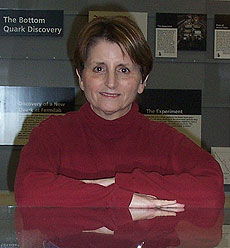The Education Office's Nancy Lanning retires after 22 years
 |
|
Nancy Lanning poses after giving a tour. Photo courtesy of the Education Office
|
Nancy Lanning is curious. In 1988, she met a Fermilab scientist. She peppered him with questions until he suggested that if she wanted to know more, she could call the laboratory. Lanning picked up the phone and, a short time later, started her 22-year career at Fermilab. She retires today.
“When I got here, the collider programs were still young. CDF had just started, and DZero was just being built. You could climb a ladder and walk into the detector since they hadn’t installed sensitive materials yet,” Lanning said.
Lanning utilized her elementary-education degree and her natural knack for teaching as a tour guide after her family moved to Illinois. She started volunteering as a tour guide out of what was then called the Office of Public Affairs (now the Office of Communication). In 1995, Lanning joined the Education Office. At Fermilab, her title changed from public information specialist to education program associate, but her mission stayed the same — to learn and help others learn.
“The tours followed Nancy to our office. She may know more people at Fermilab than any other employee," said Marge Bardeen, the Education Office manager. "Nancy has a talent for matching the interests of tour groups and scientists."
Lanning contributed to the growth of the Education Office.
“We became part of Fermilab culture,” Lanning said. She praises her colleagues as always willing to answer her many questions.
“She knows people, and she knows how to make connections,” Bardeen said. “Nancy is very generous. She’ll pitch in wherever she’s needed. We’re really going to miss her.”
Lanning stepped up to help reinvigorate Fermilab’s popular “Ask a Scientist” program in the early 2000s.
“Nancy carried our move to the Lederman Science Center and then back to Wilson Hall,” said Peter Garbincius, founder of “Ask a Scientist” and head of Fermilab’s Office of Program and Project Support. “I would find our scientists to answer the public’s questions, and Nancy would arrange anything else that needed arranging.”
Now, they split things more evenly, but Garbincius credits a lot of the success of the program’s current format to Lanning.
“She’s enthusiastic,” Garbincius said. “She’s an ideas person, and she’s energetic. When Nancy wants something, she goes after it until she gets it.”
Some things were easier to grasp than others. Lanning first heard of email at Fermilab.
“I couldn’t figure it out — how could a computer at CERN communicate with a computer at Fermilab?” she said, smiling. “I learned a lot here. After all, that’s what we do at Fermilab. We learn.”
To celebrate her retirement, there is a coffee break in Lanning’s honor today from 10:30 to 11:30 a.m. on the 15th floor south crossover of Wilson Hall.
“We wish her well,” Bardeen said on behalf of the Education Office. "And we thank her for all of the help she’s provided to the thousands of people who’ve come to Fermilab.”
—Ashley WennersHerron
|